Comprehensive Report: Agriculture Market in Australia
VerifiedAdded on 2022/11/22
|12
|2715
|415
Report
AI Summary
This report provides a comprehensive analysis of the Australian agriculture market, with a specific emphasis on the wine industry. It begins with an overview of the agricultural sector's contribution to the Australian economy, highlighting key products like wheat, beef, and wine, and their export significance. The report delves into the wine industry, examining its market structure, competitiveness, and the impact of rising export demand, particularly from China. It analyzes the factors contributing to the industry's strength, including the number of wineries and vineries, and its ability to withstand market shocks. The analysis extends to the influence of increased export demand on the price and quantity of Australian wine, illustrating how the market has expanded and increased overall revenue. The report concludes by emphasizing the importance of the agricultural sector, particularly the wine industry, to the Australian economy and its global market position.
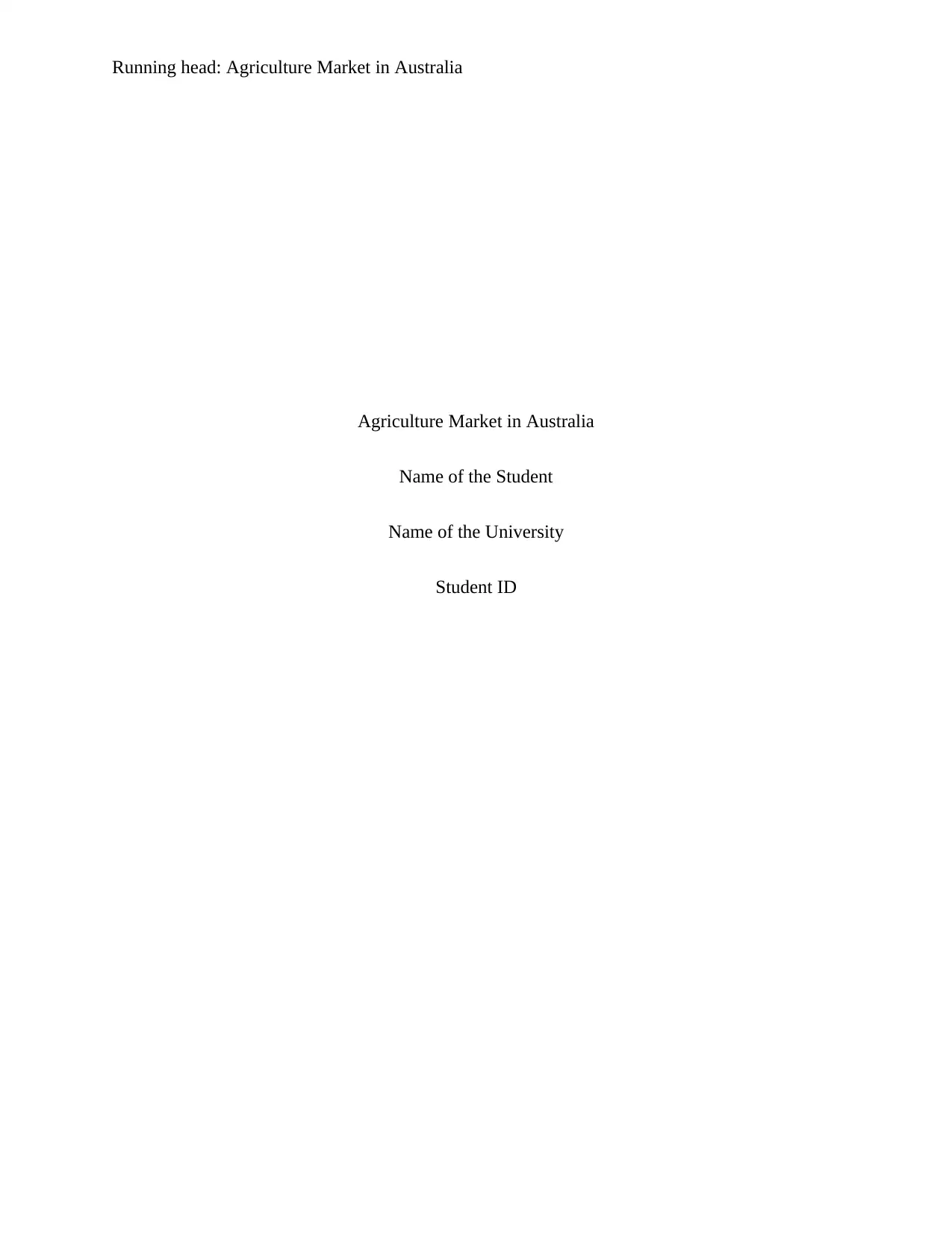
Running head: Agriculture Market in Australia
Agriculture Market in Australia
Name of the Student
Name of the University
Student ID
Agriculture Market in Australia
Name of the Student
Name of the University
Student ID
Paraphrase This Document
Need a fresh take? Get an instant paraphrase of this document with our AI Paraphraser
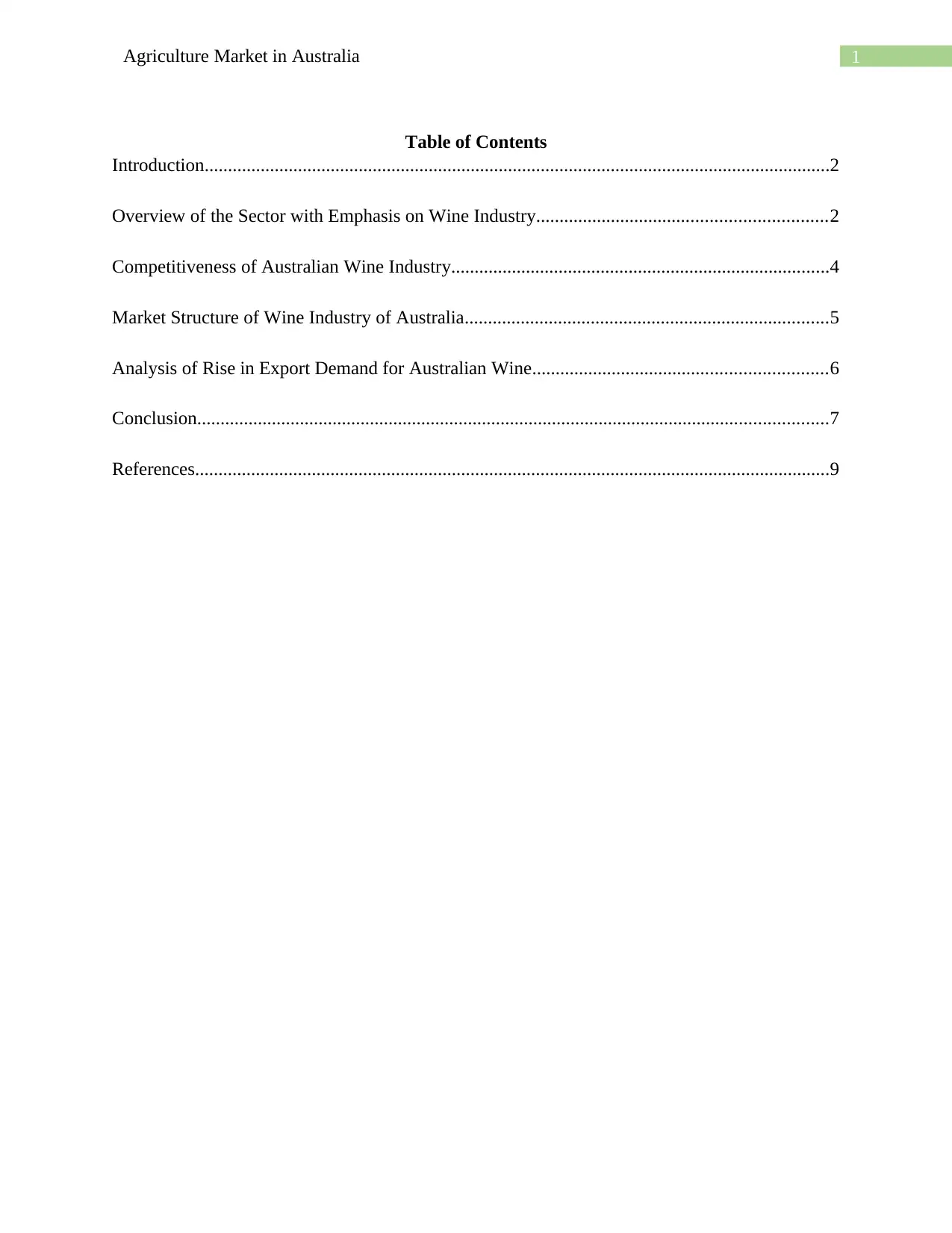
1Agriculture Market in Australia
Table of Contents
Introduction......................................................................................................................................2
Overview of the Sector with Emphasis on Wine Industry..............................................................2
Competitiveness of Australian Wine Industry.................................................................................4
Market Structure of Wine Industry of Australia..............................................................................5
Analysis of Rise in Export Demand for Australian Wine...............................................................6
Conclusion.......................................................................................................................................7
References........................................................................................................................................9
Table of Contents
Introduction......................................................................................................................................2
Overview of the Sector with Emphasis on Wine Industry..............................................................2
Competitiveness of Australian Wine Industry.................................................................................4
Market Structure of Wine Industry of Australia..............................................................................5
Analysis of Rise in Export Demand for Australian Wine...............................................................6
Conclusion.......................................................................................................................................7
References........................................................................................................................................9
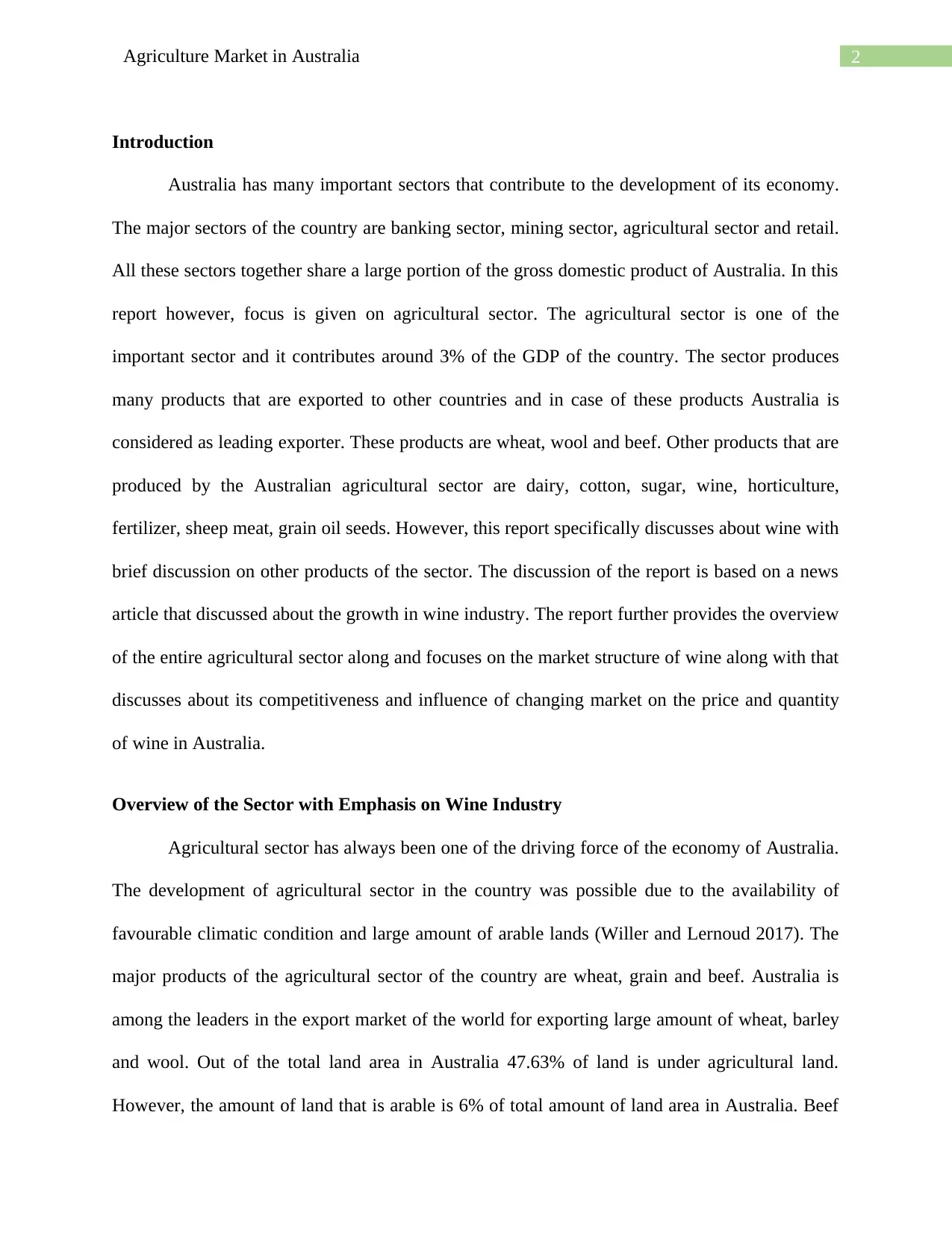
2Agriculture Market in Australia
Introduction
Australia has many important sectors that contribute to the development of its economy.
The major sectors of the country are banking sector, mining sector, agricultural sector and retail.
All these sectors together share a large portion of the gross domestic product of Australia. In this
report however, focus is given on agricultural sector. The agricultural sector is one of the
important sector and it contributes around 3% of the GDP of the country. The sector produces
many products that are exported to other countries and in case of these products Australia is
considered as leading exporter. These products are wheat, wool and beef. Other products that are
produced by the Australian agricultural sector are dairy, cotton, sugar, wine, horticulture,
fertilizer, sheep meat, grain oil seeds. However, this report specifically discusses about wine with
brief discussion on other products of the sector. The discussion of the report is based on a news
article that discussed about the growth in wine industry. The report further provides the overview
of the entire agricultural sector along and focuses on the market structure of wine along with that
discusses about its competitiveness and influence of changing market on the price and quantity
of wine in Australia.
Overview of the Sector with Emphasis on Wine Industry
Agricultural sector has always been one of the driving force of the economy of Australia.
The development of agricultural sector in the country was possible due to the availability of
favourable climatic condition and large amount of arable lands (Willer and Lernoud 2017). The
major products of the agricultural sector of the country are wheat, grain and beef. Australia is
among the leaders in the export market of the world for exporting large amount of wheat, barley
and wool. Out of the total land area in Australia 47.63% of land is under agricultural land.
However, the amount of land that is arable is 6% of total amount of land area in Australia. Beef
Introduction
Australia has many important sectors that contribute to the development of its economy.
The major sectors of the country are banking sector, mining sector, agricultural sector and retail.
All these sectors together share a large portion of the gross domestic product of Australia. In this
report however, focus is given on agricultural sector. The agricultural sector is one of the
important sector and it contributes around 3% of the GDP of the country. The sector produces
many products that are exported to other countries and in case of these products Australia is
considered as leading exporter. These products are wheat, wool and beef. Other products that are
produced by the Australian agricultural sector are dairy, cotton, sugar, wine, horticulture,
fertilizer, sheep meat, grain oil seeds. However, this report specifically discusses about wine with
brief discussion on other products of the sector. The discussion of the report is based on a news
article that discussed about the growth in wine industry. The report further provides the overview
of the entire agricultural sector along and focuses on the market structure of wine along with that
discusses about its competitiveness and influence of changing market on the price and quantity
of wine in Australia.
Overview of the Sector with Emphasis on Wine Industry
Agricultural sector has always been one of the driving force of the economy of Australia.
The development of agricultural sector in the country was possible due to the availability of
favourable climatic condition and large amount of arable lands (Willer and Lernoud 2017). The
major products of the agricultural sector of the country are wheat, grain and beef. Australia is
among the leaders in the export market of the world for exporting large amount of wheat, barley
and wool. Out of the total land area in Australia 47.63% of land is under agricultural land.
However, the amount of land that is arable is 6% of total amount of land area in Australia. Beef
⊘ This is a preview!⊘
Do you want full access?
Subscribe today to unlock all pages.

Trusted by 1+ million students worldwide
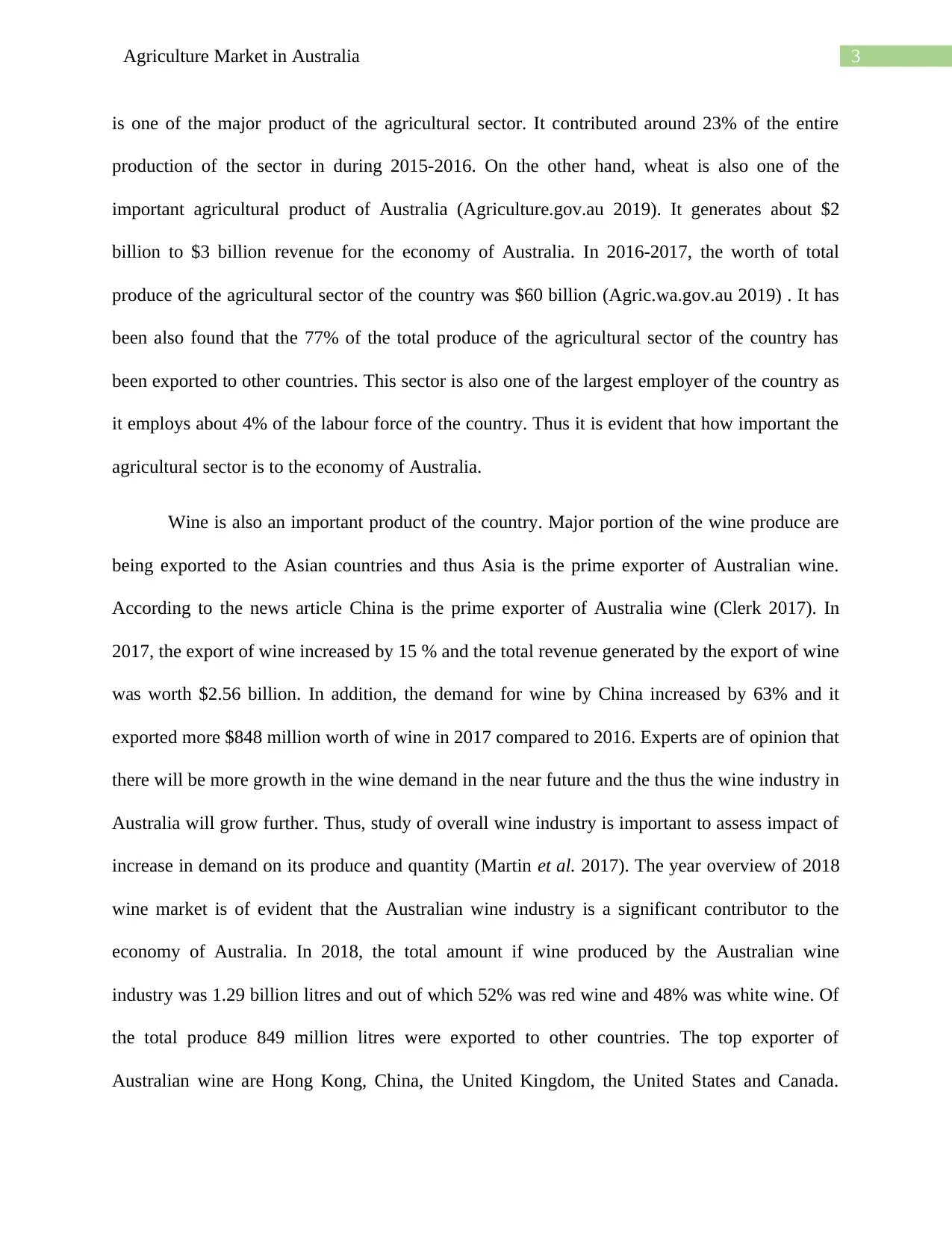
3Agriculture Market in Australia
is one of the major product of the agricultural sector. It contributed around 23% of the entire
production of the sector in during 2015-2016. On the other hand, wheat is also one of the
important agricultural product of Australia (Agriculture.gov.au 2019). It generates about $2
billion to $3 billion revenue for the economy of Australia. In 2016-2017, the worth of total
produce of the agricultural sector of the country was $60 billion (Agric.wa.gov.au 2019) . It has
been also found that the 77% of the total produce of the agricultural sector of the country has
been exported to other countries. This sector is also one of the largest employer of the country as
it employs about 4% of the labour force of the country. Thus it is evident that how important the
agricultural sector is to the economy of Australia.
Wine is also an important product of the country. Major portion of the wine produce are
being exported to the Asian countries and thus Asia is the prime exporter of Australian wine.
According to the news article China is the prime exporter of Australia wine (Clerk 2017). In
2017, the export of wine increased by 15 % and the total revenue generated by the export of wine
was worth $2.56 billion. In addition, the demand for wine by China increased by 63% and it
exported more $848 million worth of wine in 2017 compared to 2016. Experts are of opinion that
there will be more growth in the wine demand in the near future and the thus the wine industry in
Australia will grow further. Thus, study of overall wine industry is important to assess impact of
increase in demand on its produce and quantity (Martin et al. 2017). The year overview of 2018
wine market is of evident that the Australian wine industry is a significant contributor to the
economy of Australia. In 2018, the total amount if wine produced by the Australian wine
industry was 1.29 billion litres and out of which 52% was red wine and 48% was white wine. Of
the total produce 849 million litres were exported to other countries. The top exporter of
Australian wine are Hong Kong, China, the United Kingdom, the United States and Canada.
is one of the major product of the agricultural sector. It contributed around 23% of the entire
production of the sector in during 2015-2016. On the other hand, wheat is also one of the
important agricultural product of Australia (Agriculture.gov.au 2019). It generates about $2
billion to $3 billion revenue for the economy of Australia. In 2016-2017, the worth of total
produce of the agricultural sector of the country was $60 billion (Agric.wa.gov.au 2019) . It has
been also found that the 77% of the total produce of the agricultural sector of the country has
been exported to other countries. This sector is also one of the largest employer of the country as
it employs about 4% of the labour force of the country. Thus it is evident that how important the
agricultural sector is to the economy of Australia.
Wine is also an important product of the country. Major portion of the wine produce are
being exported to the Asian countries and thus Asia is the prime exporter of Australian wine.
According to the news article China is the prime exporter of Australia wine (Clerk 2017). In
2017, the export of wine increased by 15 % and the total revenue generated by the export of wine
was worth $2.56 billion. In addition, the demand for wine by China increased by 63% and it
exported more $848 million worth of wine in 2017 compared to 2016. Experts are of opinion that
there will be more growth in the wine demand in the near future and the thus the wine industry in
Australia will grow further. Thus, study of overall wine industry is important to assess impact of
increase in demand on its produce and quantity (Martin et al. 2017). The year overview of 2018
wine market is of evident that the Australian wine industry is a significant contributor to the
economy of Australia. In 2018, the total amount if wine produced by the Australian wine
industry was 1.29 billion litres and out of which 52% was red wine and 48% was white wine. Of
the total produce 849 million litres were exported to other countries. The top exporter of
Australian wine are Hong Kong, China, the United Kingdom, the United States and Canada.
Paraphrase This Document
Need a fresh take? Get an instant paraphrase of this document with our AI Paraphraser
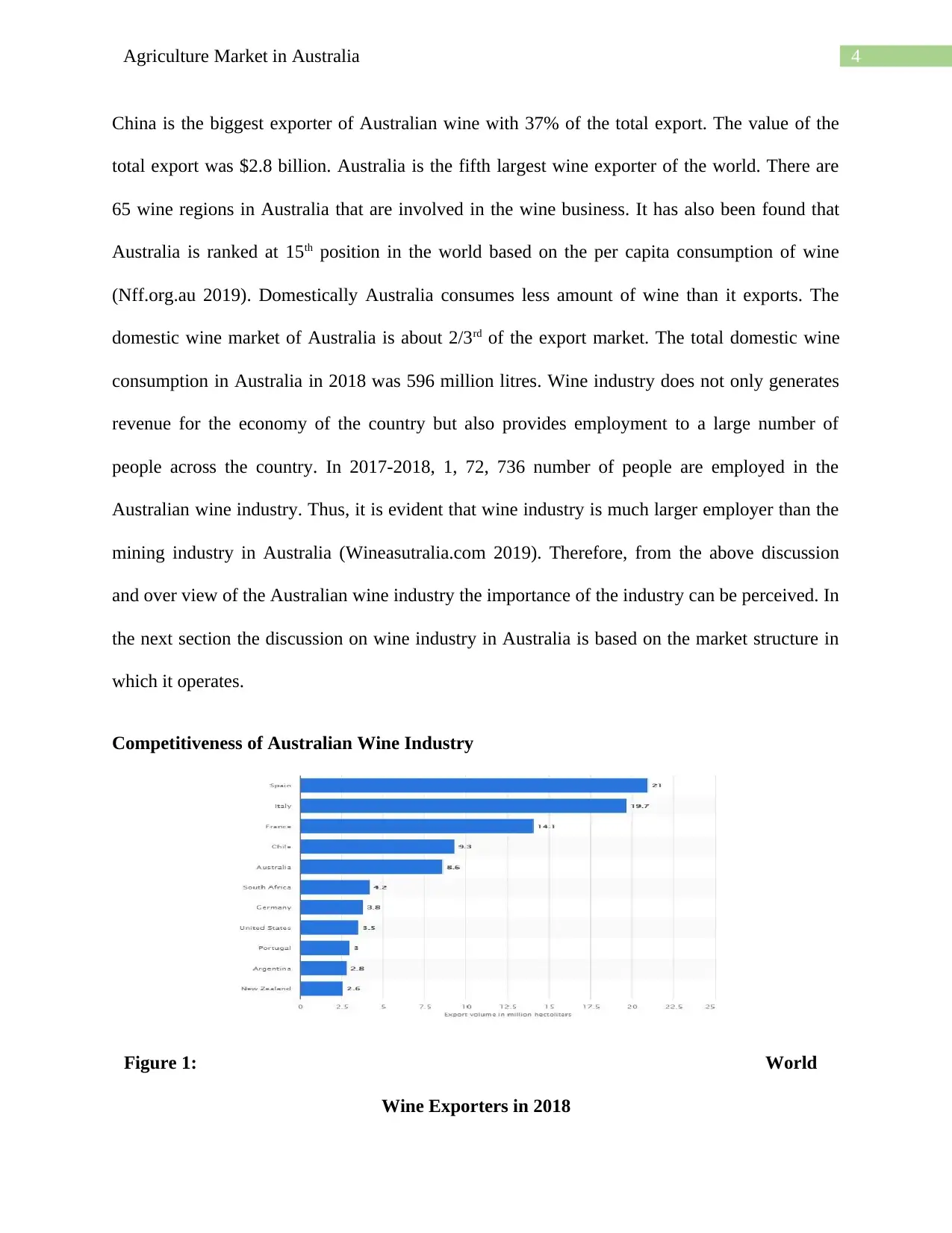
4Agriculture Market in Australia
China is the biggest exporter of Australian wine with 37% of the total export. The value of the
total export was $2.8 billion. Australia is the fifth largest wine exporter of the world. There are
65 wine regions in Australia that are involved in the wine business. It has also been found that
Australia is ranked at 15th position in the world based on the per capita consumption of wine
(Nff.org.au 2019). Domestically Australia consumes less amount of wine than it exports. The
domestic wine market of Australia is about 2/3rd of the export market. The total domestic wine
consumption in Australia in 2018 was 596 million litres. Wine industry does not only generates
revenue for the economy of the country but also provides employment to a large number of
people across the country. In 2017-2018, 1, 72, 736 number of people are employed in the
Australian wine industry. Thus, it is evident that wine industry is much larger employer than the
mining industry in Australia (Wineasutralia.com 2019). Therefore, from the above discussion
and over view of the Australian wine industry the importance of the industry can be perceived. In
the next section the discussion on wine industry in Australia is based on the market structure in
which it operates.
Competitiveness of Australian Wine Industry
Figure 1: World
Wine Exporters in 2018
China is the biggest exporter of Australian wine with 37% of the total export. The value of the
total export was $2.8 billion. Australia is the fifth largest wine exporter of the world. There are
65 wine regions in Australia that are involved in the wine business. It has also been found that
Australia is ranked at 15th position in the world based on the per capita consumption of wine
(Nff.org.au 2019). Domestically Australia consumes less amount of wine than it exports. The
domestic wine market of Australia is about 2/3rd of the export market. The total domestic wine
consumption in Australia in 2018 was 596 million litres. Wine industry does not only generates
revenue for the economy of the country but also provides employment to a large number of
people across the country. In 2017-2018, 1, 72, 736 number of people are employed in the
Australian wine industry. Thus, it is evident that wine industry is much larger employer than the
mining industry in Australia (Wineasutralia.com 2019). Therefore, from the above discussion
and over view of the Australian wine industry the importance of the industry can be perceived. In
the next section the discussion on wine industry in Australia is based on the market structure in
which it operates.
Competitiveness of Australian Wine Industry
Figure 1: World
Wine Exporters in 2018
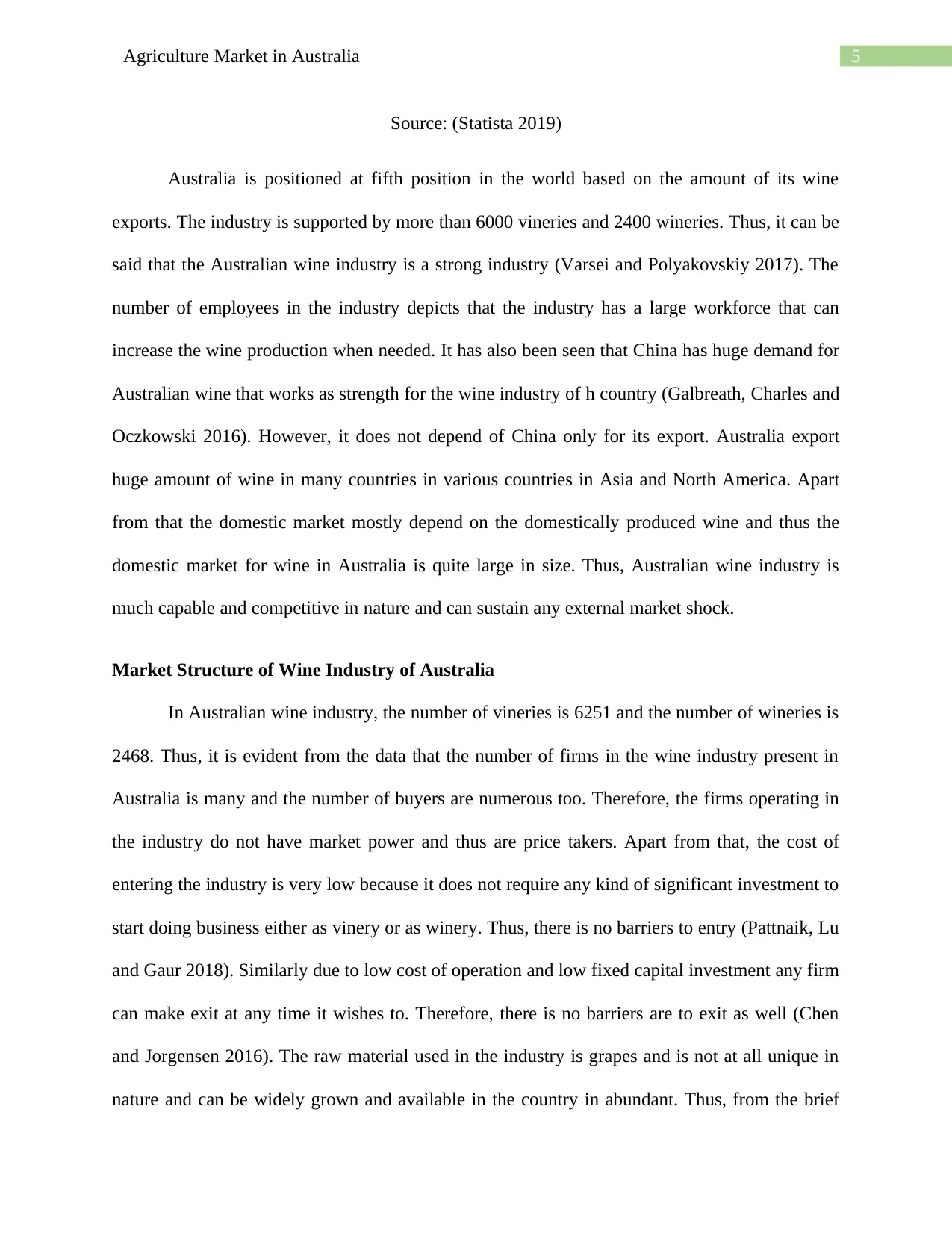
5Agriculture Market in Australia
Source: (Statista 2019)
Australia is positioned at fifth position in the world based on the amount of its wine
exports. The industry is supported by more than 6000 vineries and 2400 wineries. Thus, it can be
said that the Australian wine industry is a strong industry (Varsei and Polyakovskiy 2017). The
number of employees in the industry depicts that the industry has a large workforce that can
increase the wine production when needed. It has also been seen that China has huge demand for
Australian wine that works as strength for the wine industry of h country (Galbreath, Charles and
Oczkowski 2016). However, it does not depend of China only for its export. Australia export
huge amount of wine in many countries in various countries in Asia and North America. Apart
from that the domestic market mostly depend on the domestically produced wine and thus the
domestic market for wine in Australia is quite large in size. Thus, Australian wine industry is
much capable and competitive in nature and can sustain any external market shock.
Market Structure of Wine Industry of Australia
In Australian wine industry, the number of vineries is 6251 and the number of wineries is
2468. Thus, it is evident from the data that the number of firms in the wine industry present in
Australia is many and the number of buyers are numerous too. Therefore, the firms operating in
the industry do not have market power and thus are price takers. Apart from that, the cost of
entering the industry is very low because it does not require any kind of significant investment to
start doing business either as vinery or as winery. Thus, there is no barriers to entry (Pattnaik, Lu
and Gaur 2018). Similarly due to low cost of operation and low fixed capital investment any firm
can make exit at any time it wishes to. Therefore, there is no barriers are to exit as well (Chen
and Jorgensen 2016). The raw material used in the industry is grapes and is not at all unique in
nature and can be widely grown and available in the country in abundant. Thus, from the brief
Source: (Statista 2019)
Australia is positioned at fifth position in the world based on the amount of its wine
exports. The industry is supported by more than 6000 vineries and 2400 wineries. Thus, it can be
said that the Australian wine industry is a strong industry (Varsei and Polyakovskiy 2017). The
number of employees in the industry depicts that the industry has a large workforce that can
increase the wine production when needed. It has also been seen that China has huge demand for
Australian wine that works as strength for the wine industry of h country (Galbreath, Charles and
Oczkowski 2016). However, it does not depend of China only for its export. Australia export
huge amount of wine in many countries in various countries in Asia and North America. Apart
from that the domestic market mostly depend on the domestically produced wine and thus the
domestic market for wine in Australia is quite large in size. Thus, Australian wine industry is
much capable and competitive in nature and can sustain any external market shock.
Market Structure of Wine Industry of Australia
In Australian wine industry, the number of vineries is 6251 and the number of wineries is
2468. Thus, it is evident from the data that the number of firms in the wine industry present in
Australia is many and the number of buyers are numerous too. Therefore, the firms operating in
the industry do not have market power and thus are price takers. Apart from that, the cost of
entering the industry is very low because it does not require any kind of significant investment to
start doing business either as vinery or as winery. Thus, there is no barriers to entry (Pattnaik, Lu
and Gaur 2018). Similarly due to low cost of operation and low fixed capital investment any firm
can make exit at any time it wishes to. Therefore, there is no barriers are to exit as well (Chen
and Jorgensen 2016). The raw material used in the industry is grapes and is not at all unique in
nature and can be widely grown and available in the country in abundant. Thus, from the brief
⊘ This is a preview!⊘
Do you want full access?
Subscribe today to unlock all pages.

Trusted by 1+ million students worldwide
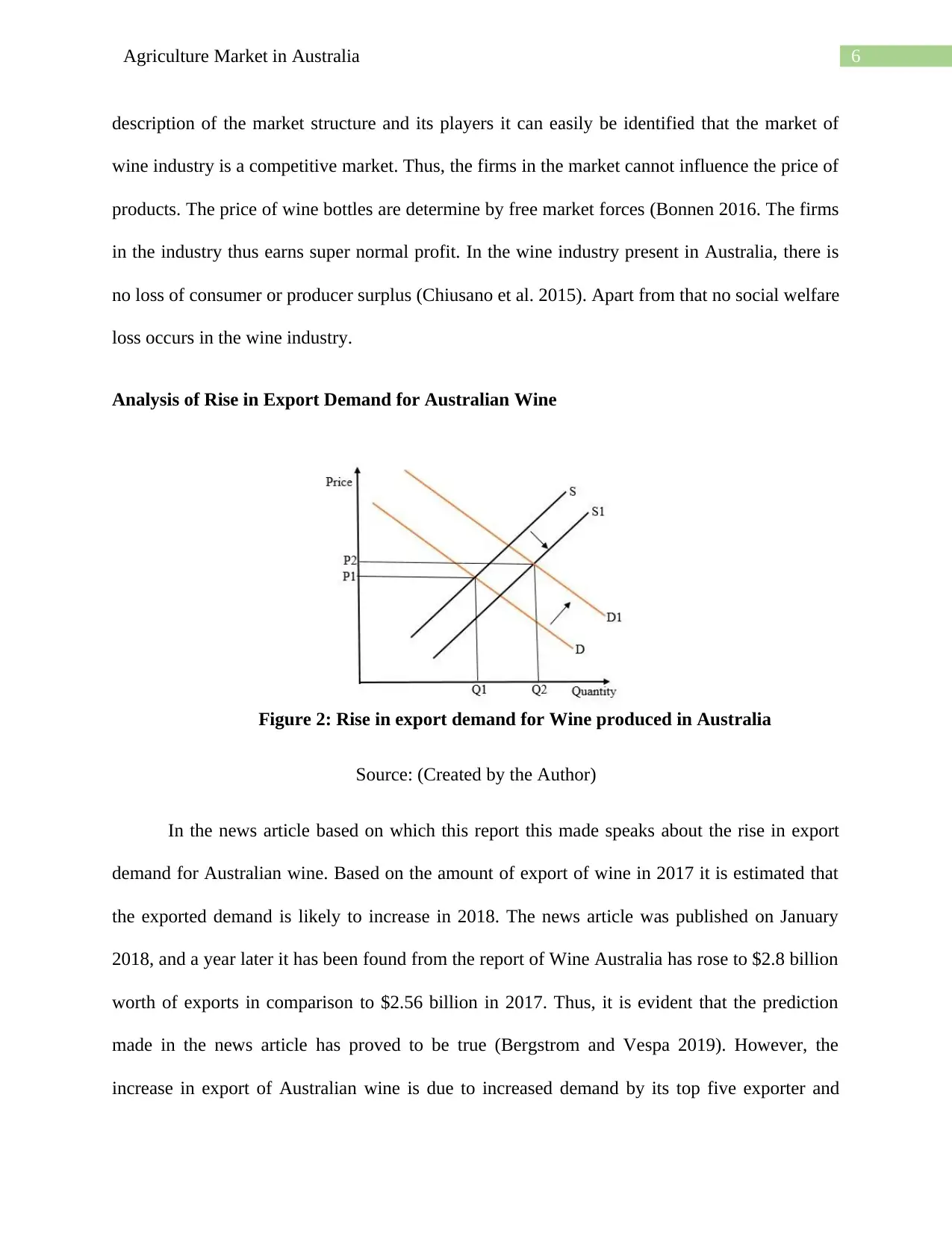
6Agriculture Market in Australia
description of the market structure and its players it can easily be identified that the market of
wine industry is a competitive market. Thus, the firms in the market cannot influence the price of
products. The price of wine bottles are determine by free market forces (Bonnen 2016. The firms
in the industry thus earns super normal profit. In the wine industry present in Australia, there is
no loss of consumer or producer surplus (Chiusano et al. 2015). Apart from that no social welfare
loss occurs in the wine industry.
Analysis of Rise in Export Demand for Australian Wine
Figure 2: Rise in export demand for Wine produced in Australia
Source: (Created by the Author)
In the news article based on which this report this made speaks about the rise in export
demand for Australian wine. Based on the amount of export of wine in 2017 it is estimated that
the exported demand is likely to increase in 2018. The news article was published on January
2018, and a year later it has been found from the report of Wine Australia has rose to $2.8 billion
worth of exports in comparison to $2.56 billion in 2017. Thus, it is evident that the prediction
made in the news article has proved to be true (Bergstrom and Vespa 2019). However, the
increase in export of Australian wine is due to increased demand by its top five exporter and
description of the market structure and its players it can easily be identified that the market of
wine industry is a competitive market. Thus, the firms in the market cannot influence the price of
products. The price of wine bottles are determine by free market forces (Bonnen 2016. The firms
in the industry thus earns super normal profit. In the wine industry present in Australia, there is
no loss of consumer or producer surplus (Chiusano et al. 2015). Apart from that no social welfare
loss occurs in the wine industry.
Analysis of Rise in Export Demand for Australian Wine
Figure 2: Rise in export demand for Wine produced in Australia
Source: (Created by the Author)
In the news article based on which this report this made speaks about the rise in export
demand for Australian wine. Based on the amount of export of wine in 2017 it is estimated that
the exported demand is likely to increase in 2018. The news article was published on January
2018, and a year later it has been found from the report of Wine Australia has rose to $2.8 billion
worth of exports in comparison to $2.56 billion in 2017. Thus, it is evident that the prediction
made in the news article has proved to be true (Bergstrom and Vespa 2019). However, the
increase in export of Australian wine is due to increased demand by its top five exporter and
Paraphrase This Document
Need a fresh take? Get an instant paraphrase of this document with our AI Paraphraser
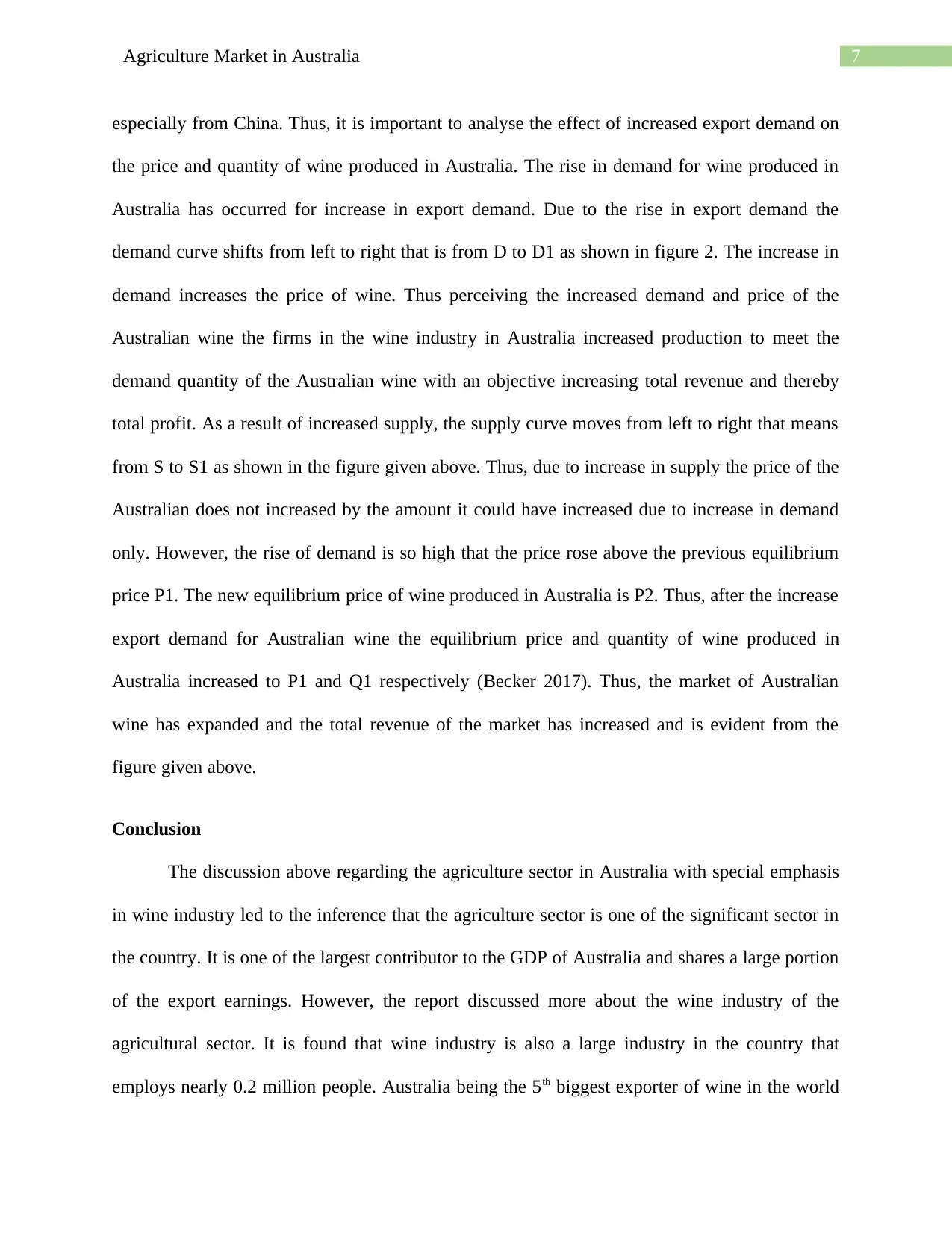
7Agriculture Market in Australia
especially from China. Thus, it is important to analyse the effect of increased export demand on
the price and quantity of wine produced in Australia. The rise in demand for wine produced in
Australia has occurred for increase in export demand. Due to the rise in export demand the
demand curve shifts from left to right that is from D to D1 as shown in figure 2. The increase in
demand increases the price of wine. Thus perceiving the increased demand and price of the
Australian wine the firms in the wine industry in Australia increased production to meet the
demand quantity of the Australian wine with an objective increasing total revenue and thereby
total profit. As a result of increased supply, the supply curve moves from left to right that means
from S to S1 as shown in the figure given above. Thus, due to increase in supply the price of the
Australian does not increased by the amount it could have increased due to increase in demand
only. However, the rise of demand is so high that the price rose above the previous equilibrium
price P1. The new equilibrium price of wine produced in Australia is P2. Thus, after the increase
export demand for Australian wine the equilibrium price and quantity of wine produced in
Australia increased to P1 and Q1 respectively (Becker 2017). Thus, the market of Australian
wine has expanded and the total revenue of the market has increased and is evident from the
figure given above.
Conclusion
The discussion above regarding the agriculture sector in Australia with special emphasis
in wine industry led to the inference that the agriculture sector is one of the significant sector in
the country. It is one of the largest contributor to the GDP of Australia and shares a large portion
of the export earnings. However, the report discussed more about the wine industry of the
agricultural sector. It is found that wine industry is also a large industry in the country that
employs nearly 0.2 million people. Australia being the 5th biggest exporter of wine in the world
especially from China. Thus, it is important to analyse the effect of increased export demand on
the price and quantity of wine produced in Australia. The rise in demand for wine produced in
Australia has occurred for increase in export demand. Due to the rise in export demand the
demand curve shifts from left to right that is from D to D1 as shown in figure 2. The increase in
demand increases the price of wine. Thus perceiving the increased demand and price of the
Australian wine the firms in the wine industry in Australia increased production to meet the
demand quantity of the Australian wine with an objective increasing total revenue and thereby
total profit. As a result of increased supply, the supply curve moves from left to right that means
from S to S1 as shown in the figure given above. Thus, due to increase in supply the price of the
Australian does not increased by the amount it could have increased due to increase in demand
only. However, the rise of demand is so high that the price rose above the previous equilibrium
price P1. The new equilibrium price of wine produced in Australia is P2. Thus, after the increase
export demand for Australian wine the equilibrium price and quantity of wine produced in
Australia increased to P1 and Q1 respectively (Becker 2017). Thus, the market of Australian
wine has expanded and the total revenue of the market has increased and is evident from the
figure given above.
Conclusion
The discussion above regarding the agriculture sector in Australia with special emphasis
in wine industry led to the inference that the agriculture sector is one of the significant sector in
the country. It is one of the largest contributor to the GDP of Australia and shares a large portion
of the export earnings. However, the report discussed more about the wine industry of the
agricultural sector. It is found that wine industry is also a large industry in the country that
employs nearly 0.2 million people. Australia being the 5th biggest exporter of wine in the world
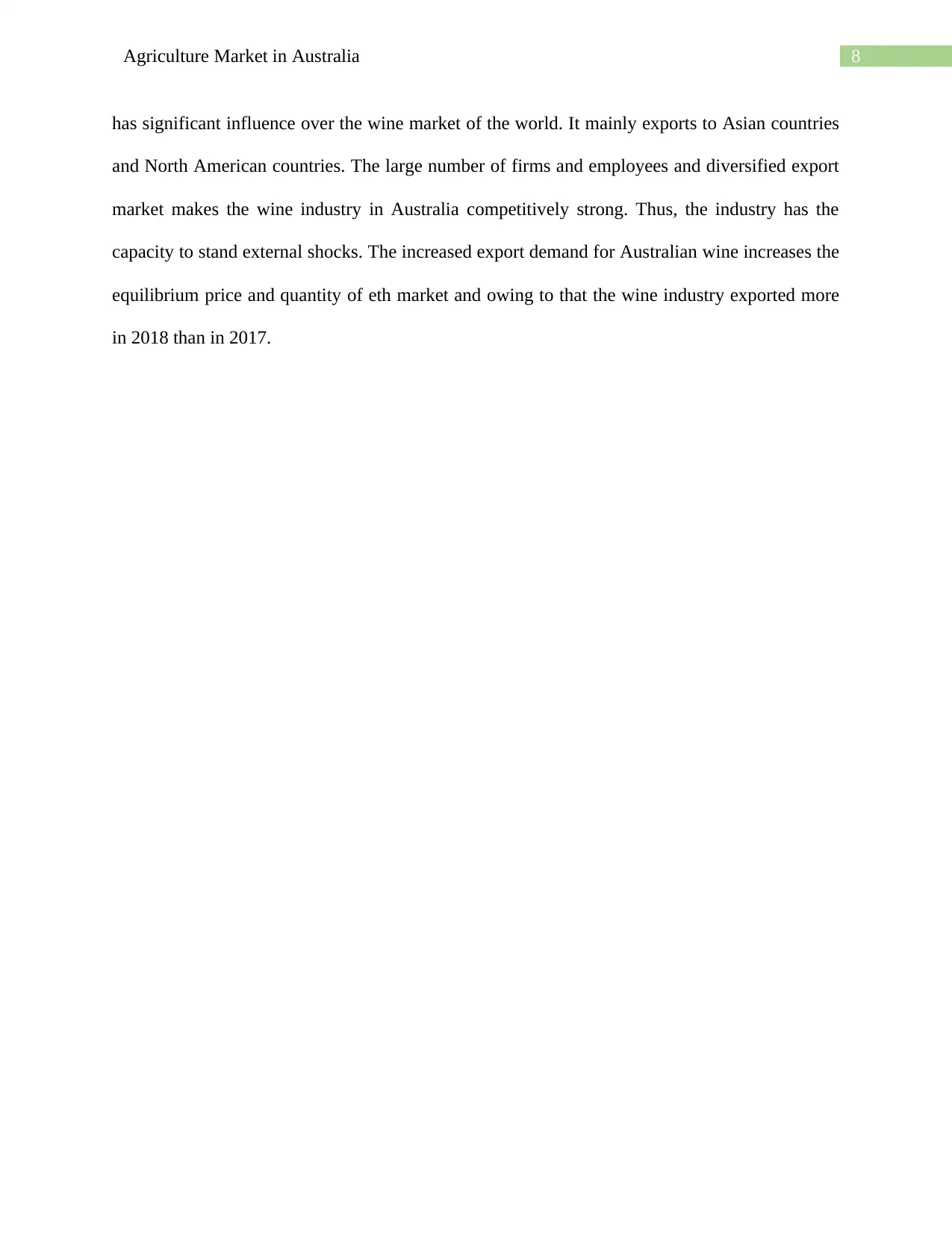
8Agriculture Market in Australia
has significant influence over the wine market of the world. It mainly exports to Asian countries
and North American countries. The large number of firms and employees and diversified export
market makes the wine industry in Australia competitively strong. Thus, the industry has the
capacity to stand external shocks. The increased export demand for Australian wine increases the
equilibrium price and quantity of eth market and owing to that the wine industry exported more
in 2018 than in 2017.
has significant influence over the wine market of the world. It mainly exports to Asian countries
and North American countries. The large number of firms and employees and diversified export
market makes the wine industry in Australia competitively strong. Thus, the industry has the
capacity to stand external shocks. The increased export demand for Australian wine increases the
equilibrium price and quantity of eth market and owing to that the wine industry exported more
in 2018 than in 2017.
⊘ This is a preview!⊘
Do you want full access?
Subscribe today to unlock all pages.

Trusted by 1+ million students worldwide
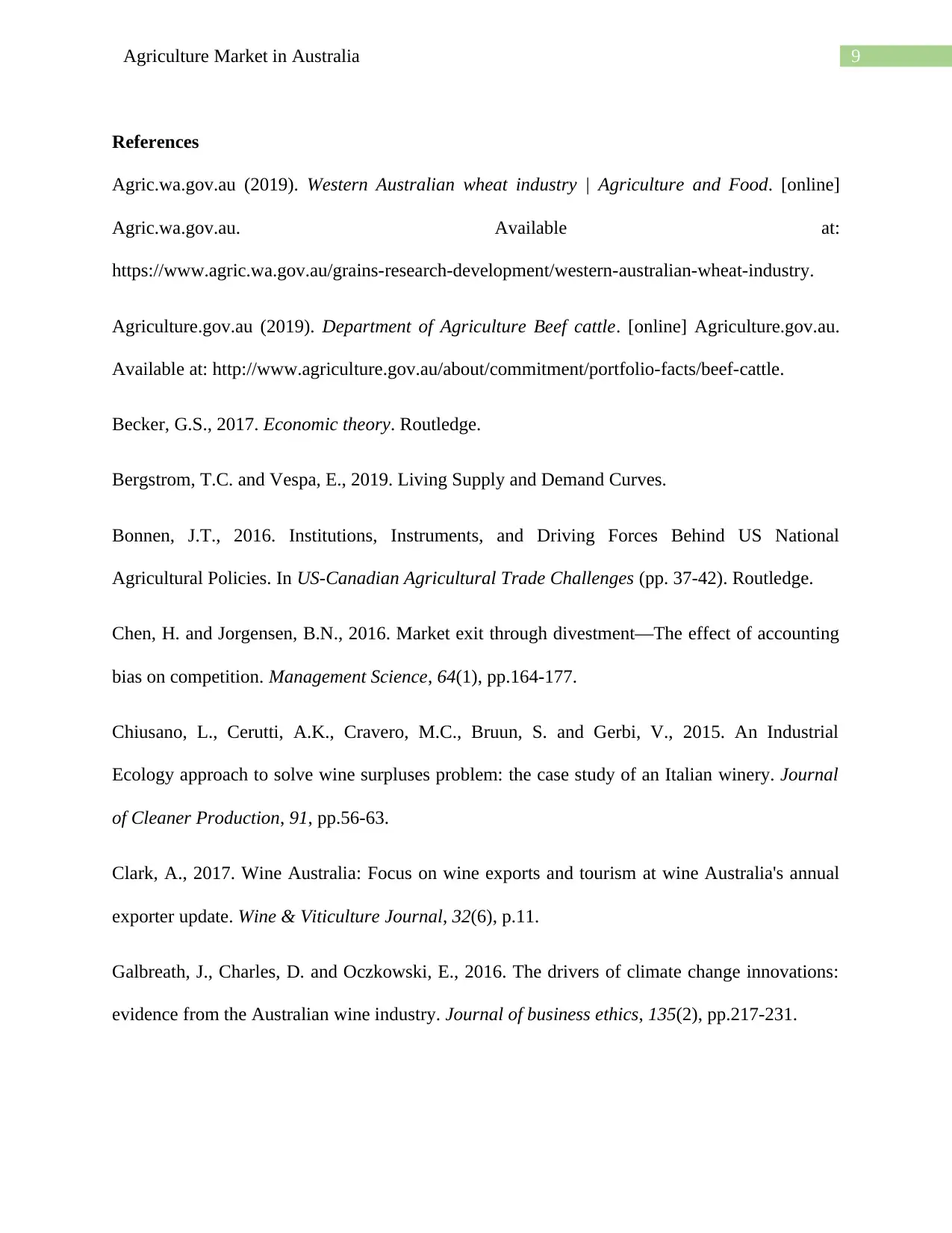
9Agriculture Market in Australia
References
Agric.wa.gov.au (2019). Western Australian wheat industry | Agriculture and Food. [online]
Agric.wa.gov.au. Available at:
https://www.agric.wa.gov.au/grains-research-development/western-australian-wheat-industry.
Agriculture.gov.au (2019). Department of Agriculture Beef cattle. [online] Agriculture.gov.au.
Available at: http://www.agriculture.gov.au/about/commitment/portfolio-facts/beef-cattle.
Becker, G.S., 2017. Economic theory. Routledge.
Bergstrom, T.C. and Vespa, E., 2019. Living Supply and Demand Curves.
Bonnen, J.T., 2016. Institutions, Instruments, and Driving Forces Behind US National
Agricultural Policies. In US-Canadian Agricultural Trade Challenges (pp. 37-42). Routledge.
Chen, H. and Jorgensen, B.N., 2016. Market exit through divestment—The effect of accounting
bias on competition. Management Science, 64(1), pp.164-177.
Chiusano, L., Cerutti, A.K., Cravero, M.C., Bruun, S. and Gerbi, V., 2015. An Industrial
Ecology approach to solve wine surpluses problem: the case study of an Italian winery. Journal
of Cleaner Production, 91, pp.56-63.
Clark, A., 2017. Wine Australia: Focus on wine exports and tourism at wine Australia's annual
exporter update. Wine & Viticulture Journal, 32(6), p.11.
Galbreath, J., Charles, D. and Oczkowski, E., 2016. The drivers of climate change innovations:
evidence from the Australian wine industry. Journal of business ethics, 135(2), pp.217-231.
References
Agric.wa.gov.au (2019). Western Australian wheat industry | Agriculture and Food. [online]
Agric.wa.gov.au. Available at:
https://www.agric.wa.gov.au/grains-research-development/western-australian-wheat-industry.
Agriculture.gov.au (2019). Department of Agriculture Beef cattle. [online] Agriculture.gov.au.
Available at: http://www.agriculture.gov.au/about/commitment/portfolio-facts/beef-cattle.
Becker, G.S., 2017. Economic theory. Routledge.
Bergstrom, T.C. and Vespa, E., 2019. Living Supply and Demand Curves.
Bonnen, J.T., 2016. Institutions, Instruments, and Driving Forces Behind US National
Agricultural Policies. In US-Canadian Agricultural Trade Challenges (pp. 37-42). Routledge.
Chen, H. and Jorgensen, B.N., 2016. Market exit through divestment—The effect of accounting
bias on competition. Management Science, 64(1), pp.164-177.
Chiusano, L., Cerutti, A.K., Cravero, M.C., Bruun, S. and Gerbi, V., 2015. An Industrial
Ecology approach to solve wine surpluses problem: the case study of an Italian winery. Journal
of Cleaner Production, 91, pp.56-63.
Clark, A., 2017. Wine Australia: Focus on wine exports and tourism at wine Australia's annual
exporter update. Wine & Viticulture Journal, 32(6), p.11.
Galbreath, J., Charles, D. and Oczkowski, E., 2016. The drivers of climate change innovations:
evidence from the Australian wine industry. Journal of business ethics, 135(2), pp.217-231.
Paraphrase This Document
Need a fresh take? Get an instant paraphrase of this document with our AI Paraphraser
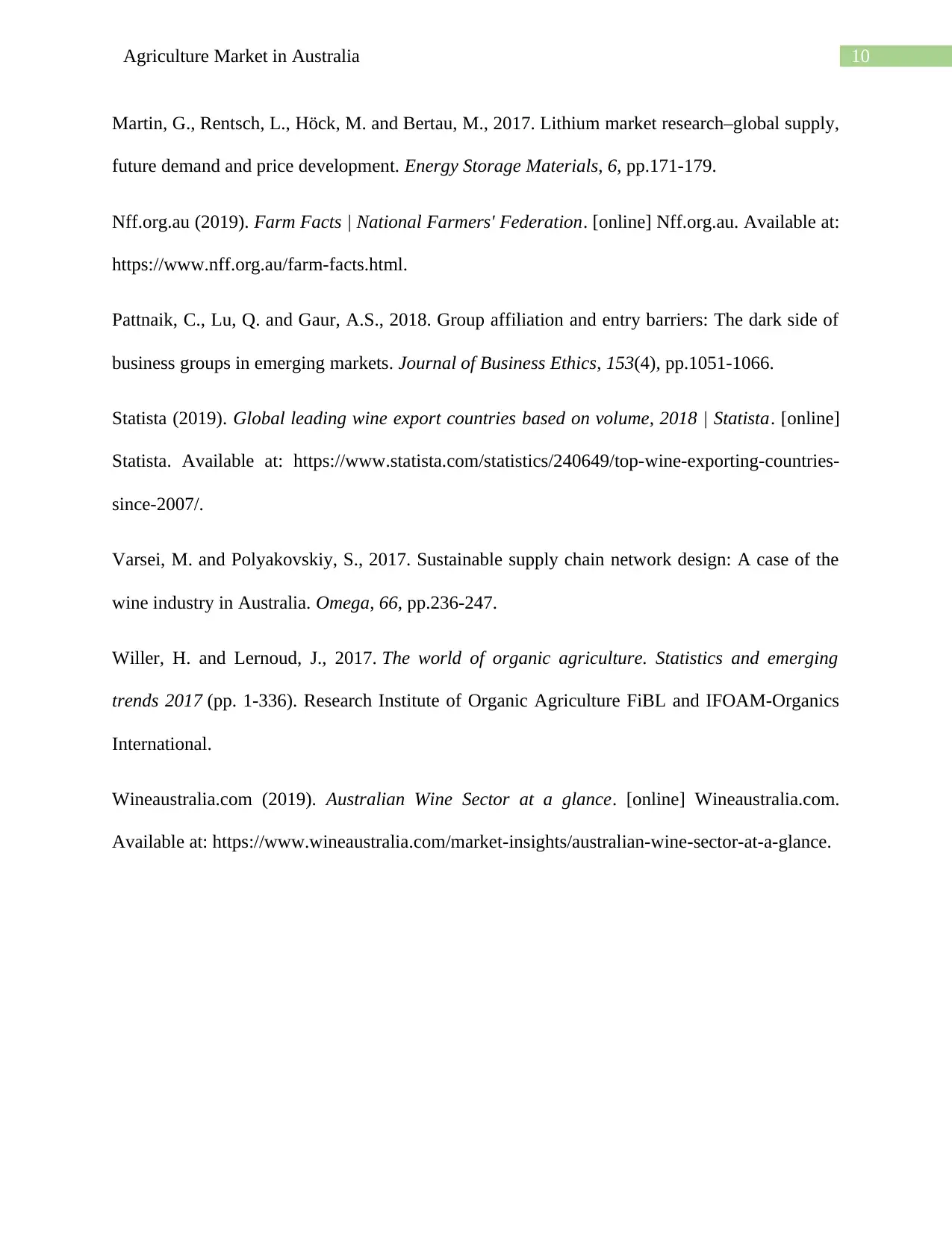
10Agriculture Market in Australia
Martin, G., Rentsch, L., Höck, M. and Bertau, M., 2017. Lithium market research–global supply,
future demand and price development. Energy Storage Materials, 6, pp.171-179.
Nff.org.au (2019). Farm Facts | National Farmers' Federation. [online] Nff.org.au. Available at:
https://www.nff.org.au/farm-facts.html.
Pattnaik, C., Lu, Q. and Gaur, A.S., 2018. Group affiliation and entry barriers: The dark side of
business groups in emerging markets. Journal of Business Ethics, 153(4), pp.1051-1066.
Statista (2019). Global leading wine export countries based on volume, 2018 | Statista. [online]
Statista. Available at: https://www.statista.com/statistics/240649/top-wine-exporting-countries-
since-2007/.
Varsei, M. and Polyakovskiy, S., 2017. Sustainable supply chain network design: A case of the
wine industry in Australia. Omega, 66, pp.236-247.
Willer, H. and Lernoud, J., 2017. The world of organic agriculture. Statistics and emerging
trends 2017 (pp. 1-336). Research Institute of Organic Agriculture FiBL and IFOAM-Organics
International.
Wineaustralia.com (2019). Australian Wine Sector at a glance. [online] Wineaustralia.com.
Available at: https://www.wineaustralia.com/market-insights/australian-wine-sector-at-a-glance.
Martin, G., Rentsch, L., Höck, M. and Bertau, M., 2017. Lithium market research–global supply,
future demand and price development. Energy Storage Materials, 6, pp.171-179.
Nff.org.au (2019). Farm Facts | National Farmers' Federation. [online] Nff.org.au. Available at:
https://www.nff.org.au/farm-facts.html.
Pattnaik, C., Lu, Q. and Gaur, A.S., 2018. Group affiliation and entry barriers: The dark side of
business groups in emerging markets. Journal of Business Ethics, 153(4), pp.1051-1066.
Statista (2019). Global leading wine export countries based on volume, 2018 | Statista. [online]
Statista. Available at: https://www.statista.com/statistics/240649/top-wine-exporting-countries-
since-2007/.
Varsei, M. and Polyakovskiy, S., 2017. Sustainable supply chain network design: A case of the
wine industry in Australia. Omega, 66, pp.236-247.
Willer, H. and Lernoud, J., 2017. The world of organic agriculture. Statistics and emerging
trends 2017 (pp. 1-336). Research Institute of Organic Agriculture FiBL and IFOAM-Organics
International.
Wineaustralia.com (2019). Australian Wine Sector at a glance. [online] Wineaustralia.com.
Available at: https://www.wineaustralia.com/market-insights/australian-wine-sector-at-a-glance.

11Agriculture Market in Australia
⊘ This is a preview!⊘
Do you want full access?
Subscribe today to unlock all pages.

Trusted by 1+ million students worldwide
1 out of 12
Related Documents
Your All-in-One AI-Powered Toolkit for Academic Success.
+13062052269
info@desklib.com
Available 24*7 on WhatsApp / Email
![[object Object]](/_next/static/media/star-bottom.7253800d.svg)
Unlock your academic potential
Copyright © 2020–2025 A2Z Services. All Rights Reserved. Developed and managed by ZUCOL.





